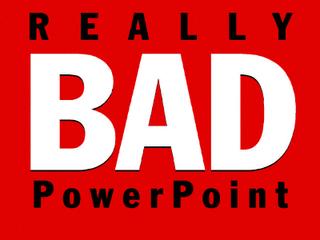
I'm far from the first person to try to tackle the problem of really bad PowerPoint. Older, wiser and much more insightful minds have been working on this problem for awhile. People like author/speaker/Marketing guru Seth Godin.
Seth, who's written several brilliant books including Permission Marketing, Purple Cow and (my personal favourite) Free Prize Inside!, a few years ago created a fantastic guide to making better PowerPoint presentations called Really Bad PowerPoint and How To Avoid It.
In his handy e-booklet, Seth's urges people to use emotion in their presentations and to use PowerPoint to communicate with their audience and to convey ideas not facts. He also includes four great tips for giving great PowerPoint presentations:
#1 Make yourself cue cards.Click the link above to download the booklet for free as a .pdf file. The intro asks that if you find it useful (and trust me, you will) to buy it for $2 from amazon.com. Seth was donating all of the proceeds he received from the sale of the ebook to charity but it's no longer available through Amazon so I'd humbly suggest considering making a donation to the Mississippi Red Cross and help the victims of the Katrina disaster instead.
This feature should be built in to PowerPoint, but it’s not. You should be able to see your cue cards on your laptop’s screen while your audience sees your slides on the wall. Alas. In the meantime, you’ll just have to resort to writing them down the old-fashioned way. Now, you can use the cue cards you made to make sure you’re saying what you came to say.
#2 Make slides that reinforce your words, not repeat them.
Create slides that demonstrate, with emotional proof, that what you’re saying is true not just accurate. Talking about pollution in Houston? Instead of giving me four bullet points of EPA data, why not show me a photo of a bunch of dead birds, some smog and even a diseased lung? Amazingly, it’s more fun than doing it the old way. But it’s effective communication.
#3 Create a written document.
A leave-behind. Put in as many footnotes or details as you like. Then, when you start your presentation, tell the audience that you’re going to give them all the details of your presentation after it’s over, and they don’t have to write down everything you say.
IMPORTANT: Don’t hand out the written stuff at the beginning. Don’t! If you do, people will read the whole thing while you’re talking and ignore you. Instead, your goal is to get them to sit back, trust you and take in the emotional and intellectual points of your presentation.
#4 Create a feedback cycle.
If your presentation is for a project approval, hand people a project approval form and get them to approve it, so there’s no ambiguity at all about what you’ve just agreed to.